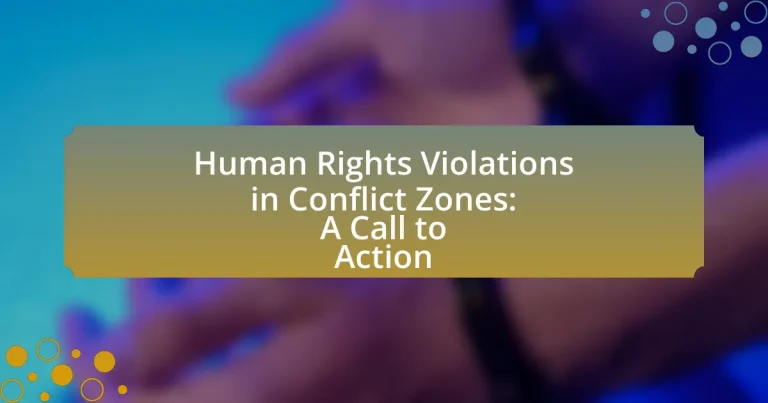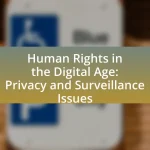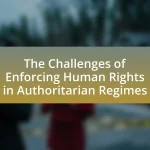Human rights violations in conflict zones encompass systematic abuses of fundamental rights during armed conflicts, including extrajudicial killings, torture, forced displacement, and sexual violence. The article examines the definitions, specific rights commonly violated, and the cultural and regional factors influencing perceptions of these violations. It highlights the breakdown of law and order and the role of armed groups in exacerbating human rights abuses, as well as the severe consequences for civilian populations and post-conflict recovery. Additionally, the article discusses the challenges faced by humanitarian organizations, the importance of international legal frameworks, and practical steps individuals can take to advocate for human rights in these critical situations.
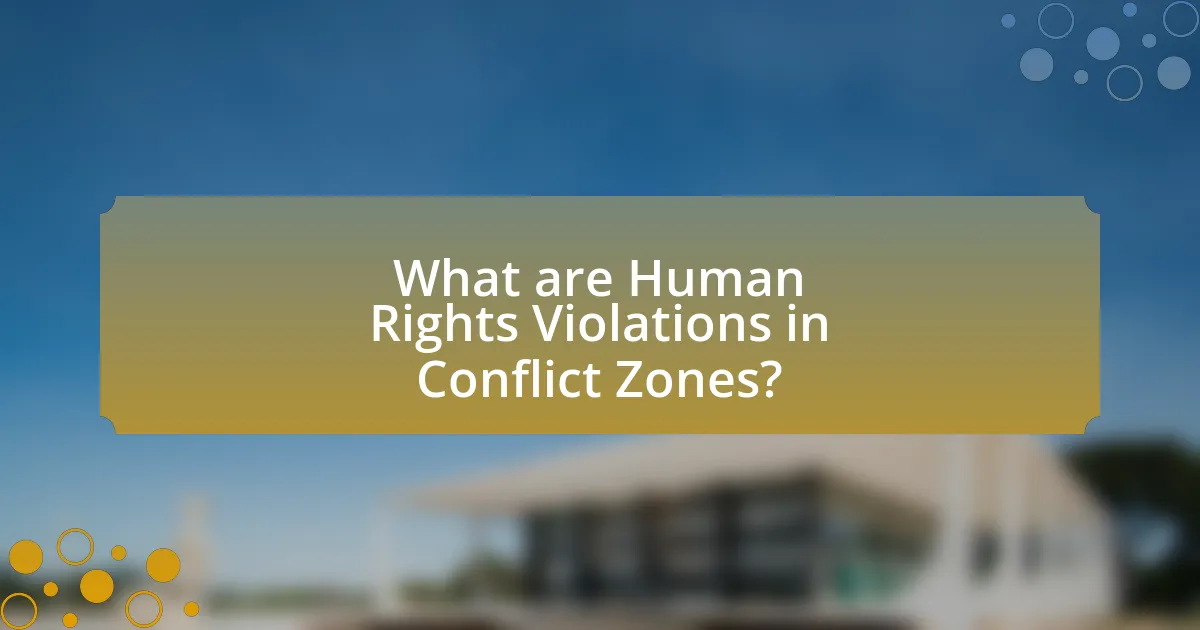
What are Human Rights Violations in Conflict Zones?
Human rights violations in conflict zones refer to the systematic abuse of fundamental rights and freedoms during armed conflicts. These violations often include acts such as extrajudicial killings, torture, forced displacement, sexual violence, and the targeting of civilians. According to the United Nations, in 2020, over 100 million people were forcibly displaced due to conflict and violence, highlighting the severe impact of such violations on populations. Furthermore, organizations like Human Rights Watch document that armed groups frequently commit war crimes, exacerbating the suffering of affected communities.
How do we define human rights violations in the context of conflict zones?
Human rights violations in conflict zones are defined as actions that infringe upon the fundamental rights and freedoms of individuals, often perpetrated by state or non-state actors during armed conflicts. These violations include acts such as extrajudicial killings, torture, forced displacement, and sexual violence, which are documented in reports by organizations like Human Rights Watch and Amnesty International. For instance, the United Nations has reported that in the Syrian conflict, over 400,000 people have been killed, with numerous documented cases of torture and arbitrary detention, illustrating the severe impact of such violations on civilian populations.
What specific rights are commonly violated during conflicts?
During conflicts, specific rights commonly violated include the right to life, the right to freedom from torture, and the right to freedom of expression. The right to life is often compromised through unlawful killings and targeted attacks against civilians, as seen in numerous armed conflicts where civilian casualties are prevalent. The right to freedom from torture is frequently disregarded, with detainees subjected to inhumane treatment and torture by state and non-state actors, as documented by organizations like Amnesty International. Additionally, the right to freedom of expression is curtailed, with journalists and activists facing threats, censorship, and violence, particularly in war zones where dissent is often met with severe repercussions. These violations are well-documented in reports from human rights organizations and international bodies, highlighting the urgent need for accountability and protection of human rights in conflict situations.
How do cultural and regional factors influence the perception of these violations?
Cultural and regional factors significantly influence the perception of human rights violations in conflict zones by shaping societal norms, values, and historical contexts. For instance, in some cultures, certain practices may be normalized or justified, leading to a diminished perception of their severity; this is evident in regions where patriarchal norms prevail, often resulting in the trivialization of gender-based violence. Additionally, regional histories of conflict can create desensitization to violence, as seen in areas with prolonged warfare, where communities may view human rights violations as a routine aspect of life rather than egregious acts. Furthermore, the influence of local media and political narratives can either amplify or downplay the significance of these violations, affecting public awareness and response. For example, in regions where government propaganda is prevalent, state-sponsored violence may be framed as necessary for national security, altering public perception and minimizing accountability.
Why are conflict zones particularly prone to human rights violations?
Conflict zones are particularly prone to human rights violations due to the breakdown of law and order, which creates an environment where abuses can occur with impunity. In these areas, armed groups often operate outside the legal framework, leading to increased violence against civilians, including torture, extrajudicial killings, and sexual violence. For instance, the United Nations has documented widespread human rights abuses in conflict zones like Syria and Yemen, where ongoing hostilities have resulted in significant civilian casualties and displacement. Additionally, the lack of accountability mechanisms in these regions further exacerbates the situation, allowing perpetrators to act without fear of repercussions.
What role does the breakdown of law and order play in these violations?
The breakdown of law and order significantly contributes to human rights violations in conflict zones by creating an environment where impunity prevails. In such contexts, the absence of effective governance and legal frameworks allows perpetrators to commit abuses without fear of accountability. For instance, during the Syrian Civil War, reports indicated that the lack of law enforcement led to widespread torture, extrajudicial killings, and sexual violence, as armed groups operated with minimal oversight. This situation illustrates how the erosion of legal structures directly facilitates the perpetration of human rights abuses, as individuals and groups exploit the chaos to violate the rights of others without repercussions.
How do armed groups contribute to the prevalence of human rights abuses?
Armed groups contribute to the prevalence of human rights abuses by engaging in violence, intimidation, and coercion against civilians. These groups often operate outside the law, leading to widespread violations such as torture, extrajudicial killings, and forced displacement. For instance, in conflict zones like Syria and Yemen, armed factions have systematically targeted non-combatants, resulting in significant civilian casualties and suffering. Reports from organizations like Human Rights Watch and Amnesty International document these abuses, highlighting that armed groups frequently exploit power vacuums and lack of accountability to perpetrate such violations with impunity.
What are the consequences of human rights violations in conflict zones?
Human rights violations in conflict zones lead to severe consequences, including loss of life, displacement of populations, and long-term psychological trauma. These violations often result in increased mortality rates due to violence, starvation, and lack of medical care; for instance, the Syrian Civil War has resulted in over 500,000 deaths and millions displaced. Additionally, survivors frequently experience lasting mental health issues, such as PTSD, which can affect entire communities and hinder post-conflict recovery. The systematic abuse of human rights can also destabilize regions, leading to prolonged conflicts and hindering peace efforts, as seen in the Democratic Republic of the Congo, where ongoing violence has perpetuated cycles of instability and suffering.
How do these violations affect civilian populations?
Human rights violations in conflict zones severely impact civilian populations by causing physical harm, psychological trauma, and displacement. Civilians often face violence, including killings, torture, and sexual violence, which can lead to long-term health issues and mental health disorders. For instance, a report by the United Nations Office for the Coordination of Humanitarian Affairs indicates that in conflict-affected areas, up to 80% of casualties are civilians, highlighting their vulnerability. Additionally, violations such as forced displacement disrupt communities, leading to loss of livelihoods and access to essential services, further exacerbating poverty and instability. The cumulative effect of these violations creates a cycle of suffering that undermines the social fabric and future recovery of affected populations.
What long-term impacts do they have on post-conflict recovery?
Human rights violations in conflict zones have significant long-term impacts on post-conflict recovery, primarily hindering social cohesion and economic development. These violations often lead to deep-seated mistrust among communities, making reconciliation efforts challenging. For instance, a study by the World Bank indicates that societies with a history of human rights abuses experience slower economic growth and increased poverty rates, as the trauma and instability disrupt normal functioning and deter investment. Additionally, the psychological effects on survivors can perpetuate cycles of violence and instability, further complicating recovery efforts.
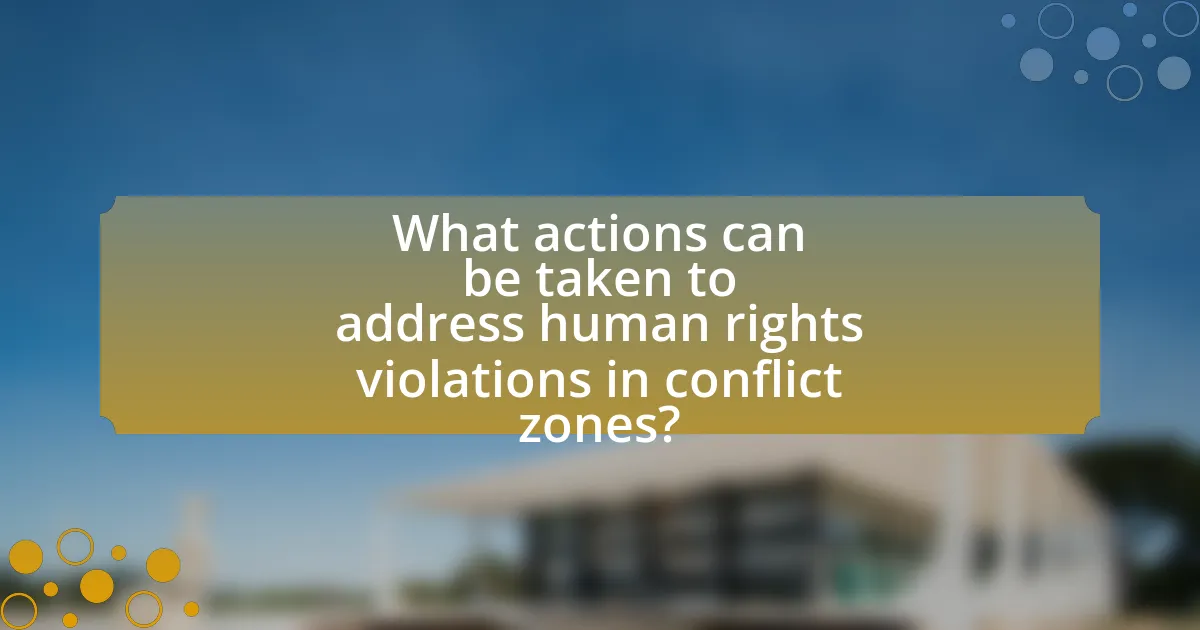
What actions can be taken to address human rights violations in conflict zones?
To address human rights violations in conflict zones, international organizations and governments can implement targeted interventions such as imposing sanctions, increasing humanitarian aid, and supporting accountability mechanisms. For instance, the United Nations has established various frameworks, like the Responsibility to Protect (R2P), which emphasizes the obligation of states to prevent atrocities and protect civilians. Additionally, the International Criminal Court (ICC) prosecutes individuals for war crimes, thereby deterring future violations. Historical examples, such as the sanctions imposed on the regime in Sudan during the Darfur conflict, demonstrate that coordinated international pressure can lead to improved conditions for affected populations.
How can international organizations intervene effectively?
International organizations can intervene effectively by employing a multifaceted approach that includes diplomatic engagement, humanitarian assistance, and monitoring mechanisms. For instance, organizations like the United Nations have successfully utilized peacekeeping missions to stabilize conflict zones, as seen in the UN’s intervention in Sierra Leone, which helped restore peace after a brutal civil war. Additionally, providing humanitarian aid, such as food and medical supplies, directly addresses the immediate needs of affected populations, exemplified by the World Food Programme’s efforts in Yemen, where millions face starvation due to ongoing conflict. Furthermore, establishing monitoring and reporting mechanisms, like the Human Rights Council’s Universal Periodic Review, ensures accountability and transparency, allowing for timely responses to human rights violations. These strategies collectively enhance the effectiveness of international organizations in addressing human rights violations in conflict zones.
What strategies have proven successful in mitigating human rights abuses?
Successful strategies for mitigating human rights abuses include the implementation of international legal frameworks, active monitoring by independent organizations, and community-based interventions. International legal frameworks, such as the Geneva Conventions, establish clear standards for the treatment of individuals in conflict zones, providing a basis for accountability. Active monitoring by organizations like Human Rights Watch and Amnesty International has proven effective in documenting abuses and pressuring governments to adhere to human rights standards. Community-based interventions, which empower local populations to advocate for their rights and provide education on human rights, have also shown success in reducing abuses, as evidenced by programs in countries like Rwanda and South Sudan that have led to increased awareness and reporting of violations.
How can local communities be empowered to protect their rights?
Local communities can be empowered to protect their rights through education, legal support, and the establishment of local governance structures. Education equips community members with knowledge about their rights and the legal frameworks that protect them, enabling informed advocacy. Legal support, such as access to pro bono legal services, helps communities navigate legal challenges and assert their rights effectively. Additionally, establishing local governance structures fosters community participation in decision-making processes, ensuring that their voices are heard and their rights are prioritized. For instance, the United Nations Development Programme emphasizes the importance of community engagement in governance to enhance accountability and protect human rights in conflict zones.
What role does advocacy play in combating human rights violations?
Advocacy plays a crucial role in combating human rights violations by raising awareness, influencing policy, and mobilizing public support. Through campaigns, advocacy groups highlight specific abuses, such as torture or unlawful detention, which can lead to international pressure on governments to change their practices. For instance, organizations like Amnesty International have successfully lobbied for the release of political prisoners and the implementation of human rights laws in various countries, demonstrating the tangible impact of advocacy efforts. Furthermore, advocacy can lead to the establishment of legal frameworks, such as the International Criminal Court, which holds perpetrators accountable for human rights violations, thereby deterring future abuses.
How can awareness campaigns influence public perception and policy?
Awareness campaigns can significantly influence public perception and policy by educating the public about human rights violations and mobilizing support for change. These campaigns often utilize various media platforms to disseminate information, raise awareness, and evoke emotional responses, which can shift public attitudes toward issues in conflict zones. For instance, the “Kony 2012” campaign effectively raised global awareness about Joseph Kony’s actions in Uganda, leading to increased public pressure on policymakers to take action. Research indicates that campaigns that effectively engage audiences can lead to policy changes, as seen in the case of the “Me Too” movement, which prompted legislative reforms addressing sexual harassment. Thus, awareness campaigns serve as catalysts for both public engagement and policy reform by highlighting urgent human rights issues.
What are the best practices for grassroots organizations in conflict zones?
Grassroots organizations in conflict zones should prioritize community engagement, security measures, and collaboration with local stakeholders. Engaging the community fosters trust and ensures that the organization’s efforts align with the needs of the population, which is crucial in volatile environments. Implementing security measures, such as risk assessments and contingency planning, protects both staff and beneficiaries from potential threats. Collaboration with local stakeholders, including other NGOs and community leaders, enhances resource sharing and increases the effectiveness of interventions. These practices are supported by the findings of the International Crisis Group, which emphasizes the importance of local knowledge and community involvement in successful conflict resolution efforts.
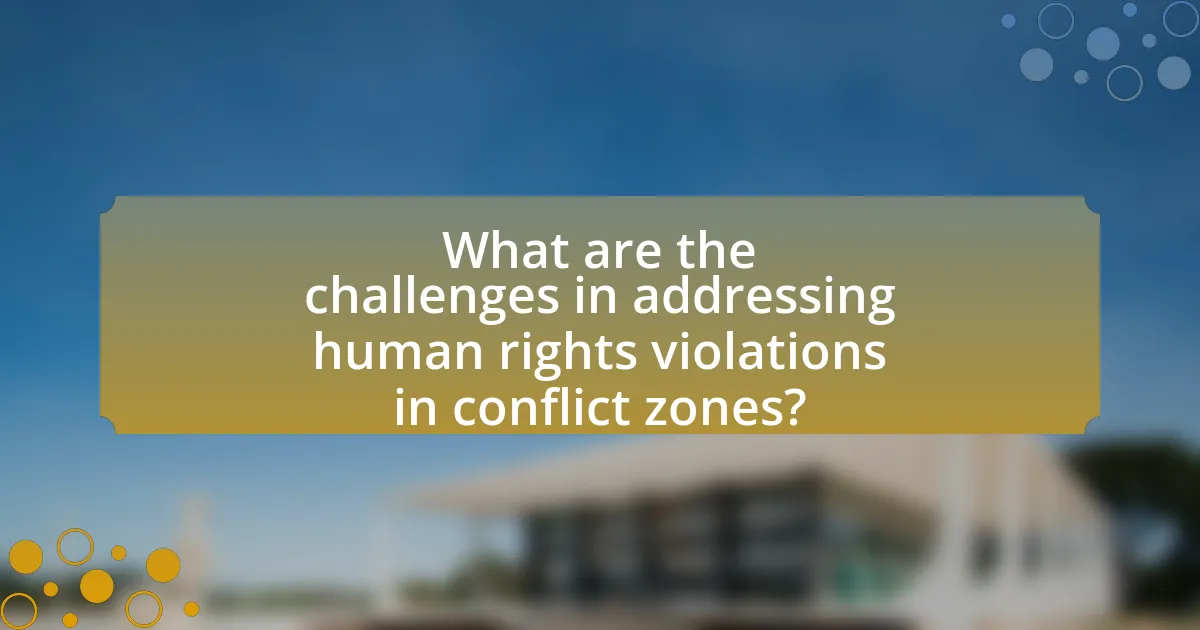
What are the challenges in addressing human rights violations in conflict zones?
Addressing human rights violations in conflict zones faces significant challenges, including lack of access, security risks, and political complexities. Humanitarian organizations often struggle to reach affected populations due to ongoing violence and restricted movement, which impedes their ability to document abuses and provide assistance. Additionally, the presence of armed groups can create dangerous environments for both victims and aid workers, leading to further violations and a culture of impunity. Political factors, such as the interests of local and international actors, can complicate accountability efforts, as governments may prioritize military objectives over human rights concerns. These challenges are evidenced by reports from organizations like Amnesty International and Human Rights Watch, which highlight the difficulties in monitoring and addressing abuses in regions like Syria and Yemen, where conflict has severely hindered humanitarian efforts.
What obstacles do humanitarian organizations face in these environments?
Humanitarian organizations face significant obstacles in conflict zones, including security risks, access restrictions, and resource limitations. Security risks arise from ongoing violence, which can threaten the safety of aid workers and hinder their ability to operate effectively. Access restrictions often result from bureaucratic hurdles or active hostilities, preventing organizations from reaching affected populations. Resource limitations, including funding shortages and logistical challenges, further complicate the delivery of essential services. According to the United Nations Office for the Coordination of Humanitarian Affairs, over 100 million people require humanitarian assistance globally, highlighting the critical need for effective intervention despite these obstacles.
How do security concerns limit access to affected populations?
Security concerns significantly limit access to affected populations by creating barriers that humanitarian organizations cannot overcome. In conflict zones, armed groups may control access routes, impose restrictions on movement, or threaten violence against aid workers, which directly hampers the delivery of essential services. For instance, according to the United Nations Office for the Coordination of Humanitarian Affairs, in 2021, over 400 humanitarian workers faced security incidents, including attacks and kidnappings, which illustrates the tangible risks involved in providing aid. These security challenges lead to reduced humanitarian presence and ultimately result in increased suffering for vulnerable populations who are unable to receive necessary assistance.
What are the implications of political interests on humanitarian efforts?
Political interests significantly undermine humanitarian efforts by prioritizing strategic gains over human welfare. For instance, during the Syrian civil war, various nations leveraged humanitarian aid as a tool for political influence, often restricting access to aid based on allegiance to specific factions. This manipulation not only delayed essential assistance but also exacerbated the suffering of civilians, as seen in the UN’s reports indicating that over 13 million people required humanitarian aid in 2021, yet access was frequently obstructed by political agendas. Such dynamics illustrate how political motivations can distort the delivery of aid, leading to increased human rights violations in conflict zones.
How can the international community support victims of human rights violations?
The international community can support victims of human rights violations by providing humanitarian aid, legal assistance, and advocacy for accountability. Humanitarian aid includes food, medical care, and shelter, which are essential for survival in conflict zones; for instance, organizations like the United Nations and NGOs have delivered aid to millions affected by crises. Legal assistance involves helping victims navigate legal systems to seek justice, as seen in the International Criminal Court’s efforts to prosecute war crimes. Advocacy for accountability includes pressure on governments and international bodies to uphold human rights standards, exemplified by the United Nations Human Rights Council’s resolutions condemning violations and calling for investigations. These actions collectively empower victims and promote a culture of accountability.
What legal frameworks exist to protect victims and hold violators accountable?
Legal frameworks that exist to protect victims and hold violators accountable include international treaties, national laws, and judicial mechanisms. The Geneva Conventions, for instance, establish legal standards for humanitarian treatment in conflict zones and obligate states to prosecute war crimes. Additionally, the International Criminal Court (ICC) provides a platform for prosecuting individuals for genocide, war crimes, and crimes against humanity, reinforcing accountability on an international level. National laws, such as the Victims of Crime Act in various countries, also offer protections and rights to victims, ensuring they receive support and justice. These frameworks collectively aim to safeguard human rights and ensure that violators face legal consequences for their actions.
How can funding and resources be effectively allocated to support recovery?
Funding and resources can be effectively allocated to support recovery by prioritizing needs assessments and evidence-based interventions. Conducting thorough needs assessments allows organizations to identify the most pressing issues faced by affected populations, ensuring that resources are directed where they are most needed. Evidence-based interventions, such as mental health support and community rebuilding programs, have been shown to facilitate recovery in conflict zones, as demonstrated by the World Bank’s findings that targeted investments in health and education can yield significant long-term benefits for communities. Additionally, establishing transparent funding mechanisms and involving local stakeholders in decision-making processes enhances accountability and ensures that resources are utilized effectively.
What practical steps can individuals take to advocate for human rights in conflict zones?
Individuals can advocate for human rights in conflict zones by raising awareness, supporting humanitarian organizations, and engaging in policy advocacy. Raising awareness involves sharing information through social media, blogs, or community events to inform others about the situation in conflict zones, which can mobilize public opinion and pressure governments. Supporting humanitarian organizations, such as the International Committee of the Red Cross or Amnesty International, through donations or volunteer work helps provide essential services and resources to affected populations. Engaging in policy advocacy includes contacting elected officials to urge them to take action, such as imposing sanctions or supporting international resolutions aimed at protecting human rights in conflict areas. These steps are effective as they leverage individual influence to create broader societal and political change, evidenced by campaigns that have successfully led to increased international attention and intervention in various conflicts.
